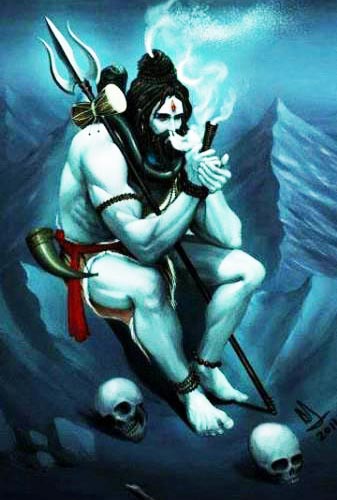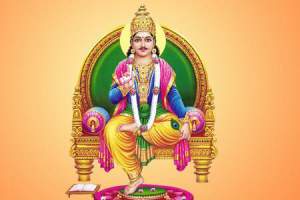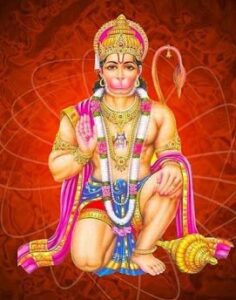
Lord Shiva is third member of Hindu trinity and is considered as the most powerful god. Lord shiva represents aspect of death or destruction. Other two gods of trinity are Lord Brahma and Lord Vishnu. Brahma is considered as the Creator and Vishnu is considered as god of life and caretaker. Shiva is usually worshipped in the form of lingam. Lord Shiva represents the aspect of the Supreme Being that continuously dissolves to recreate in the cyclic process of creation, preservation, dissolution and recreation of the universe. Lord Shiva is Known by many names – Mahadeva, Mahayogi, Maniimahesh, Pashupati, Nataraja, Bhairava, Vishwanath, Bhava, Bhole Nath – Lord Shiva is perhaps the most complex of Hindu deities. Hindus recognize this by putting his shrine in the temple separate from those of other deities.
Lord Shiva is described as an omniscient yogi, who lives an ascetic life on Mount Kailash with wife Parvati and two sons Ganesha and Kartikeya. Shiva has many benevolent as well as fearsome forms. He is often depicted as immersed in deep meditation, with his wife and children or as the Cosmic Dancer. In fierce aspects, he is often depicted slaying demons. When balance of life is disturbed and sustenance of life becomes impossible, Lord Shiva dissolves the universe for creation of the next cycle so that the souls can have another opportunity to liberate themselves from bondage with the physical world. Thus, Lord Shiva protects the souls from pain and suffering that would be caused by a dysfunctional universe.
Shiva is known to have untamed passion, which leads him to extremes in behaviour. Sometimes he is an ascetic, abstaining from all worldly pleasures. At others he is a hedonist. It is Shiva’s relationship with his wife Parvati that brings him balance. Their union allows him to be an ascetic and a lover,
In his representations as a man, Shiva always has a blue face and throat. Strictly speaking his body is white, but images often show him with a blue body too. Lord Shiva is the Lord of mercy and compassion. He protects devotees from evil forces such as lust, greed, and anger. He grants boons, bestows grace and awakens wisdom in His devotees. The symbolism discussed below includes major symbols that are common to all pictures and images of Shiva venerated by Hindus. Since the tasks of Lord Shiva are numerous, He cannot be symbolized in one form. For this reason the images of Shiva vary significantly in their symbolism.
A third eye: The extra eye represents the wisdom and insight that Shiva has. It is also believed to be the source of his untamed energy. On one occasion, when Shiva was distracted in the midst of worship by the love god, Kama, Shiva opened his third eye in anger. Kama was consumed by the fire that poured forth, and only returned to life when Parvati intervened.
A cobra around neck: This signifies Shiva’s power over the most dangerous creatures in the world. Some traditions also say that the snake represents Shiva’s power of destruction and recreation. The snake sheds its skin to make way for new, smooth skin.
The unclad body covered with ashes: the unclad body symbolizes the transcendental aspect of the Lord. Since most things reduce to ashes when burned, ashes symbolize the physical universe. The ashes on the unclad body of the Lord signify that Shiva is the source of the entire universe which emanates from Him, but He transcends the physical phenomena and is not affected by it.
The trident: A three-pronged trident shown adjacent to the Lord symbolizes his three fundamental powers of will, action and knowledge. The trident also symbolizes the Lord’s power to destroy evil and ignorance.
Half-open eyes: when the Lord opens His eyes, a new cycle of creation emerges and when He closes them, the universe dissolves for creation of the next cycle. The half-open eyes convey the idea that creation is going through cyclic process, with no beginning and no end. Lord Shiva is the Master of Yoga, as He uses His yogic power to project the universe from Himself. The half-open eyes also symbolize His yogic posture.
Ear rings (Kundalas): Kundalas, in the ears of the Lord signify that He is beyond ordinary perception. Since the kundala in the left ear of the Lord is of the type used by women and the one in His right ear is of the type used by men. These ear riings also symbolize the male and female principle of creation.
Matted locks: Lord Shiva is the Master of yoga. The three matted locks on the head of the Lord convey the idea that integration of the physical, mental and spiritual energies is the ideal of yoga.
Rudraksha necklace: Rudra is another name of Shiva. Rudraksha also means “uncompromising or strict eye”. Rudraksha necklace worn by the Lord illustrates that He uses His cosmic laws firmly – without compromise – to maintain law and order in the universe. The necklace has 108 beads which symbolize the elements used in the creation of the world.
Drum (Damaru): A small drum with two sides separated from each other by a thin neck-like structure symbolizes the two utterly dissimilar states of existence. When a Damaru is vibrated, it produces dissimilar sounds which are fused together by resonance to create one sound. The sound thus produced symbolizes Nada, the cosmic sound of AUM, which can be heard during deep meditation. According to Hindu scriptures, Nada is the source of creation.
Kamandalu: A water pot (Kamandalu) made from a dry pumpkin contains nectar and is shown on the ground next to Shiva. The process of making Kamandalu has deep spiritual significance. A ripe pumpkin is plucked from a plant, its fruit is removed and the shell is cleaned for containing the nectar. In the same way, an individual must break away from attachment to the physical world and clean his inner self of egoistic desires in order to experience the bliss of the Self, symbolized by the nectar in the Kamandalu.
The crescent moon: is shown on the side of the Lord’s head as an ornament, and not as an integral part of His countenance. The waxing and waning phenomenon of the moon symbolizes the time cycle through which creation evolves from the beginning to the end. Since the Lord is the Eternal Reality, He is beyond time. Thus, the crescent moon is only one of His ornaments, and not an integral part of Him.
Tiger skin: a tiger skin symbolizes potential energy. Lord Shiva, sitting on or wearing a tiger skin, illustrates the idea that He is the source of the creative energy that remains in potential form during the dissolution state of the universe. Of His own Divine Will, the Lord activates the potential form of the creative energy to project the universe in endless cycles.
Nandi: the bull is associated with Shiva and is said to be His vehicle. The bull symbolizes both power and ignorance. Lord Shiva’s use of the bull as a vehicle conveys the idea that He removes ignorance and bestows power of wisdom on His devotees. The bull is called Vrisha in Sanskrit. Vrisha also means dharma (righteousness). Thus a bull shown next to Shiva also indicates that He is the etemal companion of righteousness.
Ganga: Ganga (river Ganges) is associated with Hindu mythology and is the most sacred river of Hindus. According to tradition, one who bathes in Ganga (revered as Mother Ganga) in accordance with traditional rites and ceremonies on religious occasions in combination with certain astrological events, is freed from sin and attains knowledge, purity and peace. Ganga, symbolically represented on the head of the Lord by a female (Mother Ganga) with a jet of water emanating from her mouth and falling on the ground, signifies that the Lord destroys sin, removes ignorance, and bestows knowledge, purity and peace on the devotees.
The God who needs to be high

As Lord Shiva is regarded as a mighty destructive power which often leads to uncontrolled anger in lord Shiva. Hence, to numb his negative potentials Lord Shiva is fed with opium orcannabis. Lord Shiva is also termed as ‘Bhole Shankar’, one who is oblivious of the world. According to legend which led to Lord Shiva’s association with Cannabis (Bhang in India), Shiva wandered off into the fields after an angry discourse with his family. Drained from the family conflict and the hot sun, he fell asleep under a leafy plant. When he awoke, his curiosity led him to sample the leaves of the plant. Instantly rejuvenated, Shiva made the plant his favourite food and he became known as the Lord of Bhang.
Therefore, on Maha Shivratri, the night of Shiva worship, devotees, prepare an intoxicating drink called ‘Thandai’ or ‘Ghota’ (made from cannabis, almonds, and milk) sing songs in praise of the Lord Shiva and dance to the rhythm of the drums. Bhang is offered to Shiva images. Some of the wandering ascetics in India known as Sadhus smoke cannabis out of a clay chillum.
Avatars
The first Incarnation was that of Mahakal and the counterpart Maha Vidya was of Maha Kali. The next was that of Tar and the corresponding Shaki was Tara. The third incarnation of Siva was Bhuvaneswar and the complement was Bhuvanewari while the fourth was Sodash or Sri Vidyesh and the matching Shakti was Sodashi or Sri. Parameswara’s fifth Avatar was Bhairav and the balancing Shakti was Bhiravi. Chhinnamastak Siva was the counter part of Chhinnamasta in the Sixth Incarnation. Dhumavan and Dhumavati were Siva and Shakti of the Seventh while the Eighth Avatars manifested as Bhagala Mukh and Bhagalamba. Matang and Matangi are the corresponding names of Siva and Shakti in the Ninth Incarnation and finally the Avatars of Siva and Mahavidyas were Kamal and Kamala.
Main incarnations of Lord Shiva
Bhairava
Bhairava is one of the incarnations of Lord Shiva and is often represented with a third eye, long teeth and hair of flames. This incarnation is seen wearing a garland of skulls. Bhairava holds a snake and trident in his left arm and holds a noose and a cup in his right arm. He is seen standing with his vehicle, a dog, behind him. The deity Bhairava has several other forms in which he is represented having five heads and ten arms. Bhairava worked as a door guardian and he is also known as Kshetrapala while Mahakala worked as a faith guardian or dharmapala.
Allama Prabhu
Allama Prabhu was among the Vira Shaiva, a less popular incarnation of Lord Shiva. He was believed to be a Brahmin who acted very closely with the elder Basava either as a primary instigator, or subsequent assistant. Later became Basava`s spiritual adviser. Allama Prabhu was involved in the revolution at Kalyanapuri in which the Bijala raja was slain and a new religion was established.
Khandoba
Khandoba is one of the incarnations of Lord Shiva and can be often seen with the elements such as a sword, drum, trident and bowl. The vehicle of Khandoba is a horse and he may be seen associated with a dog. The sect of Khandoba is not considered to be very old. According to one of the legends, the God made himself known to a number of cowherds who were resting in a field but went away again when one of his most pious worshippers approached. Thus, the devotee was disappointed very much and the elders of the village became suspicious about the significance of a Linga that was found on the spot where Khandoba appeared. A strange contest was held to end such doubt.
Apart from these, there are various other incarnations of Lord Shiva including Shveta, Sutara, Madana, Suhotra, Kankana, Lokaksi, Jaigisavya, Dadivaha, Rishabha, Bhrgu, Ugra, Atri, Bali, Gautama, Vedashiras, Gokarna, Shikandaka, Jatamali, Attahasa, Daruka, Langali, Mahayama, Muni, Suli, Pindamunishvara, Sahishnu, Somashara and Nakulishvara.
Lord Siva’s ‘Ekadasa Rudra’ manifestations
As Daithyas were constantly distressing Devas, the latter approached Sage Kashyap. The Sage too felt quite upset with the evil actions prepetrated by the Demons and desired to secure a lasting solution to punish the Demons. He executed a rigorous ‘Tapasya’ to the most merciful Shankara who appeared and rewarded with a windfall that soon the tribulations by Daityas would vanish as He would bless Devi Surabhi with Eleven Expressions as Eakadasa Rudras ( Eleven Rudras) to wipe out the Daithyas engaged in the tortures by the Demons. The Ekadasa Rudras were: Kapali, Pingal, Bheem, Virupaksha, Vilohit, Shastra, Ajapaada, Ahirbudhya, Shamshu, Chand and Bhava. A whole generation of Demons was indeed wiped out by the Grace of Maha Deva.
Shiva as lord Hanuman
When Lord Vishnu incarnated as Rama on earth, Lord Shiva took the form of Lord Hanuman as a monkey to serve His master. In Indian spiritual history, there never has been, and never will be, a devotee as complete and profound as Lord Hanuman. His parents were Pawan, the Wind God, and his wife Anjana. Hanuman was a bundle of mischief when he was a child. He was very active. So he had a very healthy appetite too. Most of the time he was hungry. He was ready to eat anything that was tasty and within his reach.


